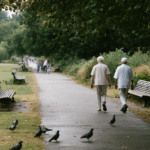The relationship between a person’s connection to nature and their overall well-being is closely influenced by the socioeconomic status of the area in which they live. This is the key finding from a recent analysis by researchers at Kobe University, who examined the impact of district-level socioeconomic conditions on nature-related well-being. The study, led by human environmental scientist Uchiyama Yuta, surveyed 3,500 residents across two major metropolitan regions in Japan—Tokyo-Yokohama and Osaka-Kobe. The aim was to explore how the proximity to and personal perception of nature influence well-being, considering the often overlooked but critical role of economic disparities.
Many city dwellers have fond memories of outdoor activities like hiking, camping, or simply walking through a local park—activities that nurture a sense of connection to the natural world. Yet, in modern urban environments, access to nature can vary dramatically depending on socioeconomic conditions. Wealthier neighbourhoods often have more green spaces and better infrastructure for outdoor activities. At the same time, economically disadvantaged areas tend to lack these amenities, compounding the stress and health challenges their residents face. Despite these apparent disparities, few studies have comprehensively examined the links between socioeconomic status, nature exposure, and well-being at a district level.
To fill this gap, Uchiyama and his team adopted a multifaceted approach. They measured both objective and subjective nature-relatedness among the participants. Objective measures included physical proximity to parks and natural areas, while subjective assessments captured personal feelings of connection to nature. These responses were then analysed alongside district-level socioeconomic data, adding a third, critical layer to understanding how these factors interact to shape well-being.
The findings, published in the journal Landscape and Urban Planning, reveal a clear trend: individuals who feel more connected to nature report higher levels of well-being. This effect is particularly strong in economically disadvantaged, densely urbanised districts. In these areas, access to green spaces serves as a crucial buffer against the stresses of urban life, offering a rare but vital source of mental and physical relief.
But why is this relationship so pronounced in less affluent areas? Previous studies have suggested that people living under significant financial and social stress derive greater benefit from natural environments, as these spaces offer respite from the daily pressures that wealthier residents can often offset through other means, such as private gardens, fitness facilities, or wellness services. In contrast, those in higher-income districts, while still benefiting from nature, have a broader range of resources available to support their health and happiness, potentially diluting the relative impact of nature exposure.
Reflecting on the implications for urban planning and public health, Uchiyama remarked, “We anticipate that conserving and enhancing existing natural spaces, as well as organising community-focused outdoor activities, could significantly boost well-being in economically disadvantaged areas. Interestingly, our findings also highlight that childhood experiences with nature strongly predict adult well-being.” This suggests that policies ensuring equitable early-life exposure to natural environments could have lasting, positive impacts on public health.
Looking ahead, the research team plans to expand their work to explore how factors such as residential mobility and changes in socioeconomic status over time influence nature-related well-being. Uchiyama noted, “Our findings align with similar studies conducted in other regions, indicating that interventions targeting both subjective and objective connections to nature could be widely applicable, including in other rapidly urbanising regions such as Monsoon Asia.” As part of an ongoing international collaborative project, the team is now examining the links between environmental awareness, resilience, and well-being in cities like Bangkok and Manila, hoping to generate insights that can guide urban policy worldwide.
More information: Yuta Uchiyama et al, Association between objective and subjective relatedness to nature and human well-being: Key factors for residents and possible measures for inequality in Japan’s megacities, Landscape and Urban Planning. DOI: 10.1016/j.landurbplan.2025.105377
Journal information: Landscape and Urban Planning Provided by Kobe University








